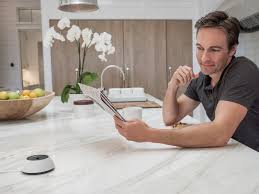Voice-controlled smart home devices have revolutionized the way we interact with our living spaces, bringing a new level of convenience, efficiency, and style. Among the many smart home innovations, voice-controlled kitchen lighting stands out as a practical and powerful tool. In this guide, we’ll explore how you can use voice commands to control your kitchen lights, from setting up the right system to maximizing its benefits for energy efficiency, ambiance, and convenience.
Understanding Voice-Controlled Kitchen Lighting

Voice-controlled kitchen lighting allows you to manage your lights through simple verbal commands, eliminating the need for physical switches. This technology is powered by smart assistants like Amazon Alexa, Google Assistant, and Apple Siri, which communicate with smart lighting systems to execute your commands.
Popular Voice Assistants
- Amazon Alexa: Compatible with a wide range of smart lighting brands, Alexa is one of the most versatile voice assistants for controlling kitchen lights.
- Google Assistant: Known for its intuitive interface and seamless integration with Google’s ecosystem, Google Assistant is another powerful option for voice-controlled lighting.
- Apple Siri: For those deeply invested in the Apple ecosystem, Siri offers robust voice control over HomeKit-compatible smart lights.
Types of Smart Lights
- Smart Bulbs: These replace your existing light bulbs and can be controlled via voice commands. They offer features like dimming, color changing, and scheduling.
- Smart Switches: These replace your traditional light switches and can control any connected light fixture. They’re ideal for those who want to keep their existing bulbs but gain voice control functionality.
- Smart Light Strips: Perfect for under-cabinet or accent lighting, smart light strips can be controlled with voice commands for mood lighting or task lighting in the kitchen.
Benefits of Using Voice Commands for Kitchen Lights
Voice-controlled kitchen lighting offers a multitude of benefits that go beyond just the convenience of hands-free operation.
Convenience and Hands-Free Operation
One of the most significant advantages of voice-controlled lighting is the ability to control your kitchen lights without using your hands. Whether you’re in the middle of cooking and your hands are messy, or you’re carrying groceries and can’t reach the switch, a simple voice command can turn the lights on or off, adjust brightness, or even change the color temperature.
Enhancing Accessibility
For individuals with disabilities or mobility challenges, voice-controlled lights can be life-changing. It provides an easy way to operate the lights without needing to physically interact with switches, making the kitchen more accessible to everyone in the household.
Energy Efficiency
Voice-controlled lighting can help you save energy by making it easier to turn lights on or off as needed, reducing wasteful energy consumption.
Optimizing Light Usage
By integrating your smart lights with voice assistants, you can create routines that automatically turn off lights when they’re not needed, or adjust brightness based on the time of day. For instance, you can set your kitchen lights to dim during dinner time or brighten when you start cooking, all through a simple voice command.
Integration with Other Smart Devices
Voice-controlled lights can also be integrated with other smart devices like thermostats or sensors to optimize energy usage. For example, you can set up a routine where the lights dim when the thermostat reaches a certain temperature, reducing the load on your HVAC system and saving energy.
Enhanced Kitchen Ambiance
Creating the right ambiance in your kitchen is easy with voice-controlled lighting. Whether you want bright, focused light for cooking or a warm, soft glow for dining, you can achieve the perfect lighting mood with just a few words.
Customizing Lighting Moods
Smart lights offer customizable settings that allow you to create different moods for different occasions. You can create a “Cooking Mode” that provides bright task lighting, or a “Dinner Mode” that dims the lights for a more relaxed atmosphere. These scenes can be activated with a simple voice command, transforming your kitchen with ease.
Synchronizing with Other Smart Devices
You can enhance your kitchen experience by synchronizing your lights with other smart devices. For example, you can set up your lights to pulse or change colors along with your favorite music, or to dim automatically when you start watching a movie in the adjacent room.
Setting Up Voice-Controlled Kitchen Lighting
To get started with voice-controlled kitchen lighting, you’ll need to choose the right smart lighting system, install the necessary hardware, and pair your lights with a compatible voice assistant.
Choosing the Right Smart Lighting System
When selecting a smart lighting system for your kitchen, consider the following factors:
Smart Bulbs vs. Smart Switches
- Smart Bulbs: Ideal if you want to replace your existing bulbs with a more versatile option. They are easier to install and offer features like color changing and dimming.
- Smart Switches: Best if you want to control multiple lights with one switch or keep your existing light fixtures. These require more complex installation but offer greater flexibility in controlling your lights.
Compatibility with Voice Assistants
Ensure that the smart lighting system you choose is compatible with your preferred voice assistant. Most major brands, like Philips Hue, LIFX, and TP-Link, work seamlessly with Amazon Alexa, Google Assistant, and Apple Siri.
Installation Process
The installation process varies depending on whether you’re installing smart bulbs or smart switches.
Installing Smart Bulbs
- Remove the Existing Bulbs: Unscrew your current bulbs from the fixtures.
- Install the Smart Bulbs: Screw in the smart bulbs just like you would with regular bulbs.
- Set Up the App: Download the manufacturer’s app and follow the instructions to connect the bulbs to your home Wi-Fi network.
- Pair with Voice Assistant: Use the app to link your bulbs with your voice assistant.
Installing Smart Switches
- Turn Off the Power: Switch off the power at the circuit breaker to avoid electrical shocks.
- Remove the Old Switch: Unscrew and disconnect the wires from your existing switch.
- Install the Smart Switch: Connect the wires to the smart switch according to the manufacturer’s instructions, then screw it into place.
- Turn On the Power: Switch the power back on at the circuit breaker.
- Set Up the App: Follow the manufacturer’s app instructions to connect the switch to your Wi-Fi and pair it with your voice assistant.
Pairing with Voice Assistants
Once your smart lights are installed, the next step is to pair them with your voice assistant.
Amazon Alexa
- Open the Alexa App: Go to the “Devices” tab.
- Add a Device: Tap the “+” icon and select “Light” or “Switch.”
- Follow the Prompts: Alexa will guide you through the process of connecting your smart lights.
Google Assistant
- Open the Google Home App: Tap the “+” icon in the top left corner.
- Set Up Device: Choose “Set up device” and follow the prompts.
- Link Your Lights: Select your smart lights from the list and link them to Google Assistant.
Apple Siri
- Open the Home App: Tap “Add Accessory.”
- Scan the QR Code: Use your camera to scan the QR code on your smart lights or packaging.
- Follow the Setup Process: Siri will guide you through the setup.
How to Use Voice Commands to Control Kitchen Lights
With your smart lights set up and connected to your voice assistant, you can now start using voice commands to control them.
Basic Voice Commands
- Turning Lights On/Off: “Alexa, turn on the kitchen lights” or “Hey Google, turn off the kitchen lights.”
- Dimming/Brightening Lights: “Siri, dim the kitchen lights to 50%” or “Google, brighten the kitchen lights.”
Adjusting Brightness Levels
You can easily adjust the brightness of your kitchen lights to suit your needs. For example, during meal prep, you might want bright lighting for better visibility, while during dinner, a softer light might be preferable.
Creating Custom Lighting Scenes
Custom lighting scenes allow you to set specific lighting configurations for different activities.
Setting Up Scenes
- Create in App: Use the manufacturer’s app to set up different scenes, such as “Cooking,” “Dining,” or “Relaxing.”
- Activate with Voice Command: “Alexa, activate Cooking Mode” will adjust the lights to your pre-set cooking scene.
Setting Schedules and Routines
You can automate your kitchen lights to follow specific schedules or routines.
Example Routines
- Morning Routine: “Hey Google, good morning” can turn on the kitchen lights gradually to simulate sunrise.
- Evening Routine: “Alexa, good night” can dim or turn off the lights automatically at a set time.
Advanced Voice Control Features
For even more control, explore advanced features like changing light colors or grouping lights.
Changing Light Colors
If your smart bulbs support color changes, you can use voice commands to set the mood. “Siri, set the kitchen lights to blue” can create a cool ambiance for evening relaxation.
Grouping Lights
Group multiple lights together for collective control. “Alexa, turn on all kitchen lights” will simultaneously control all lights in the kitchen.
Troubleshooting Common Issues
While voice-controlled lights are generally reliable, you might encounter some issues.
Connectivity Problems
If your lights aren’t responding to voice commands, it could be a connectivity issue.
Solutions
- Restart Devices: Try rebooting your smart lights, voice assistant, and Wi-Fi router.
- Check Wi-Fi Signal: Ensure that your lights are within range of your Wi-Fi network.
Voice Assistant Not Recognizing Commands
Sometimes, your voice assistant may not recognize your commands.
Tips for Improvement
- Clear and Specific Commands: Make sure you’re using the correct name for your lights and speaking clearly.
- Adjust Sensitivity: Some assistants allow you to adjust the sensitivity to better recognize your voice.
Syncing Issues with Multiple Devices
If you have multiple smart devices, syncing them can sometimes be challenging.
Managing Multiple Devices
- Group Devices: Group your kitchen lights under a single command for easier control.
- Regular Updates: Keep all devices updated with the latest firmware to ensure compatibility.
Maximizing the Use of Voice-Controlled Kitchen Lights
To get the most out of your voice-controlled kitchen lights, consider integrating them with other smart devices and using them for safety and energy efficiency.
Integrating with Other Smart Kitchen Devices
Voice-controlled lights can work in harmony with other smart kitchen gadgets.
Examples of Integration
- Smart Thermostats: Adjust the lighting based on room temperature for comfort and efficiency.
- Smart Speakers: Synchronize lights with music for an immersive cooking experience.
Safety and Security Considerations
Voice-controlled lights can also enhance kitchen safety and security.
Simulating Occupancy
Set up routines that turn lights on and off to simulate occupancy when you’re not home, deterring potential intruders.
Setting Alerts
You can set up alerts to notify you if the lights turn on unexpectedly, which could indicate unusual activity in your home.
Energy-Saving Tips
Maximize your energy savings by optimizing how and when your kitchen lights are used.
Automating Lights to Turn Off
Set your lights to turn off automatically after a certain period of inactivity to reduce energy waste.
Energy Monitoring
Some smart lighting systems offer energy monitoring features, allowing you to track your usage and identify opportunities for savings.
Conclusion
Voice-controlled kitchen lighting is more than just a trendy gadget—it’s a tool that enhances the convenience, efficiency, and ambiance of your home. By setting up and using voice commands effectively, you can create a kitchen environment that is both functional and stylish. Whether you’re cooking, dining, or simply relaxing, the ability to control your kitchen lights with your voice adds a new level of ease and sophistication to your daily routine. So go ahead, experiment with different setups and routines, and enjoy the future of smart kitchen living.




